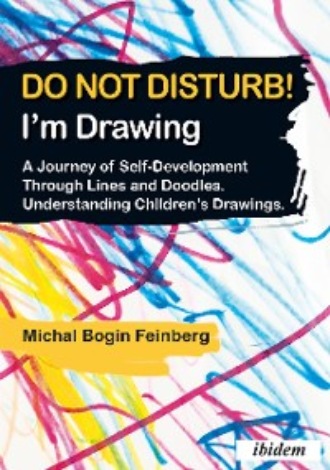
Полная версия
Do not Disturb! I'm Drawing
The doodling progresses into drawings with clear shapes that can be perceived as a “portrayal of one’s soul”, an illustration portraying the emotional development that is occurring simultaneously.
In the beginning of the process, the act is instinctive and it involves several different senses. There are many different undefined directions in the first doodles. It appears that the child draws as a way of exploring and playing solely for himself. As his drawings progress, his shapes become clearer and clearer—with separate lines for example—and demonstrate the construction of his identity as a separate self, and forming stability. The formation of a “sense of self” as a process of letting go of the illusion of the child’s oneness with his mother is also a formation of the idea that there exists such a thing as an “other.”
Later on, with the existence of such an “other,” the child realizes rather quickly that he is being observed, and the way in which he is being observed will begin to have an influence on him. The relationship with the “other” progresses and begins to influence the child’s awareness to the presence of an “other.” The drawing child learns that the “other” responds, and those responses begin to be meaningful to him and influence the way in which he draws. Once he has this awareness, he begins to have the need to please the observer. The child begins to perceive his own self according to the reaction of the other.
Jacques Lacan, one of the greatest psychoanalysts, has written a lot about the role of the gaze and its meaning to the process of the infant’s growth. This stage of development of awareness to the existence of a “self” and of an “other”, was named by Lacan “the mirror stage.” According to Lacan, this is a process in which the “me” begins to form out of the image and the reflection of the “other” within him.
The journey of finding the “real self” and the attempt to estimate how much the other is embedded within, along with the extent of the influence of the other – begins only now. The dialogue between the child obeying the expectations of an “other,” and the child obeying his own needs and desires, will go on for many years to follow. From what we can gather, attention and awareness given to the manner of observing, along with a response which encourages the child to create in an honest and a carefree way, are very important in keeping the child’s “self,” his confidence, and the feeling that he is loved for who he is. This response will have an influence on his happiness and creativity.
During the following chapters, I will describe in more depth and detail the movements and the development of the child, which occur simultaneously in his drawings and in his inner emotional world.
Конец ознакомительного фрагмента.
Текст предоставлен ООО «ЛитРес».
Прочитайте эту книгу целиком, купив полную легальную версию на ЛитРес.
Безопасно оплатить книгу можно банковской картой Visa, MasterCard, Maestro, со счета мобильного телефона, с платежного терминала, в салоне МТС или Связной, через PayPal, WebMoney, Яндекс.Деньги, QIWI Кошелек, бонусными картами или другим удобным Вам способом.



